期末语法复习课件2022-2023学年外研版英语七年级上册(共102张PPT)
文档属性
| 名称 | 期末语法复习课件2022-2023学年外研版英语七年级上册(共102张PPT) | 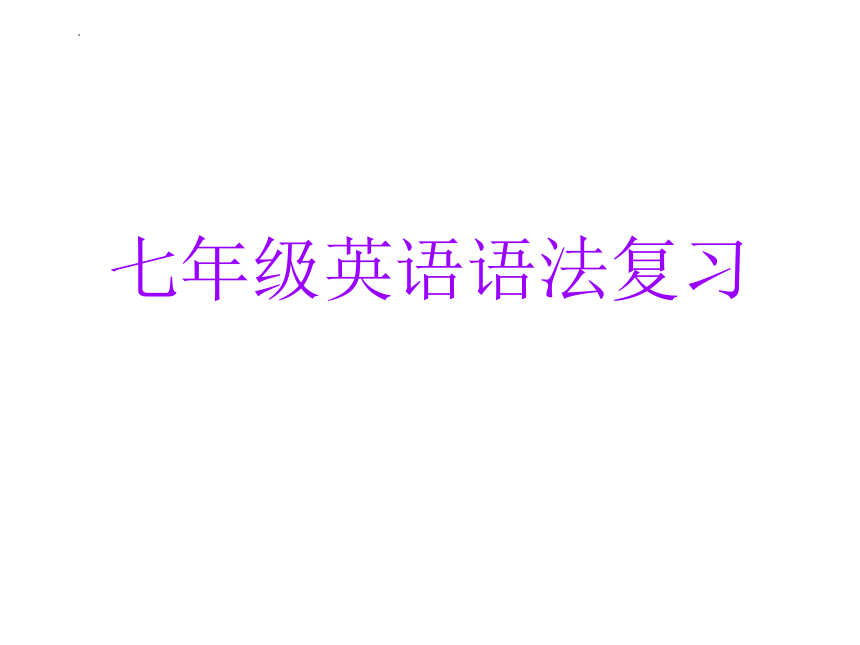 | |
| 格式 | pptx | ||
| 文件大小 | 38.6MB | ||
| 资源类型 | 教案 | ||
| 版本资源 | 外研版 | ||
| 科目 | 英语 | ||
| 更新时间 | 2022-12-15 14:46:02 | ||
图片预览


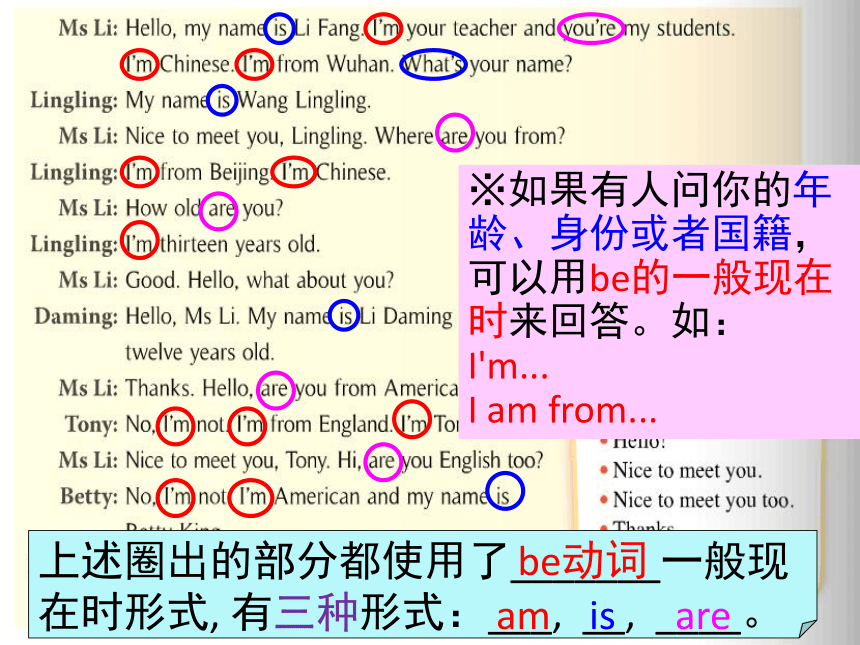
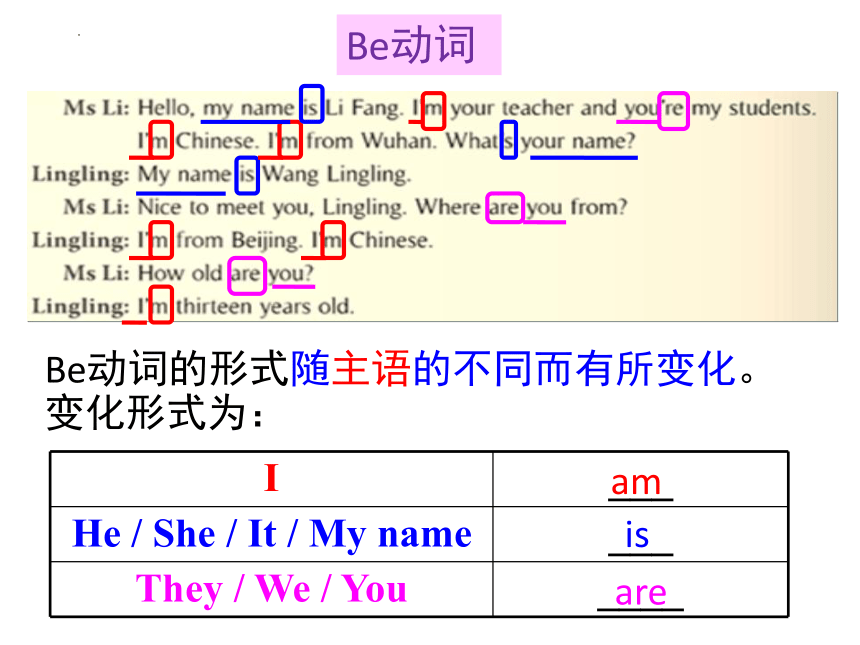
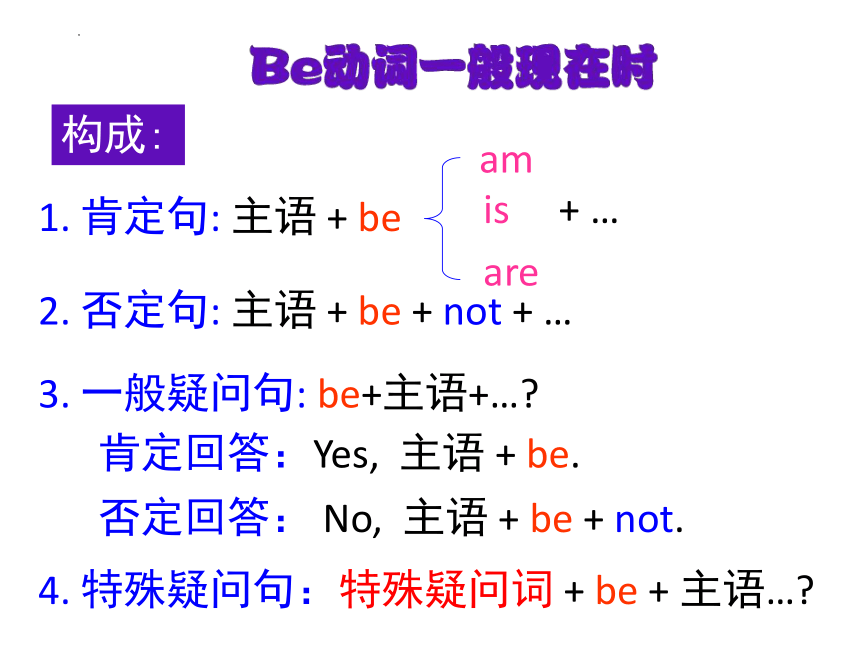
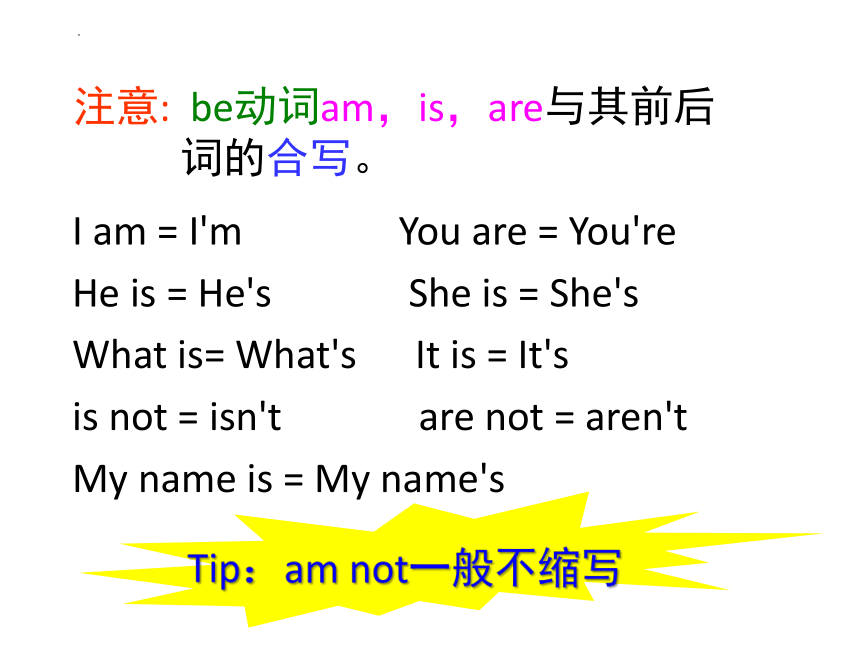
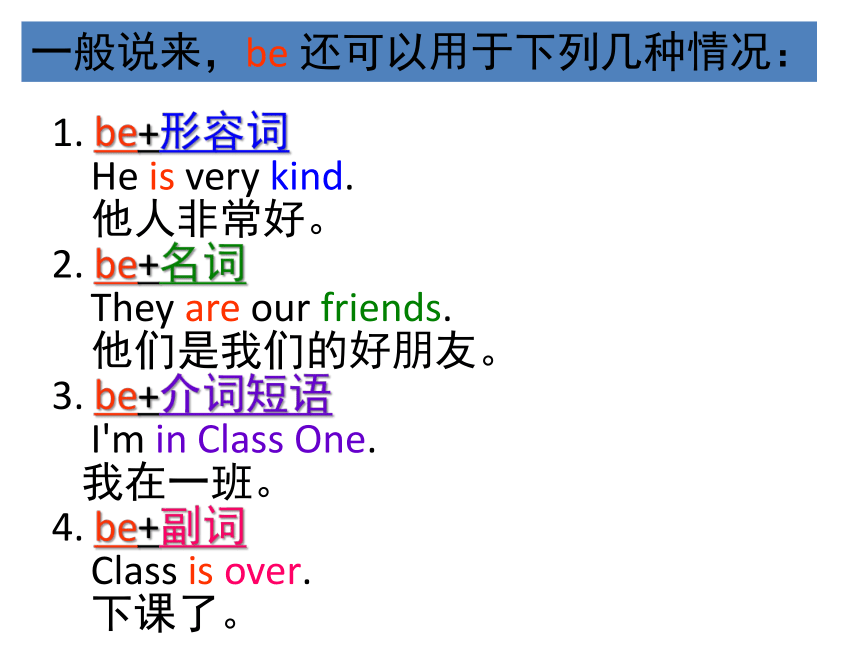

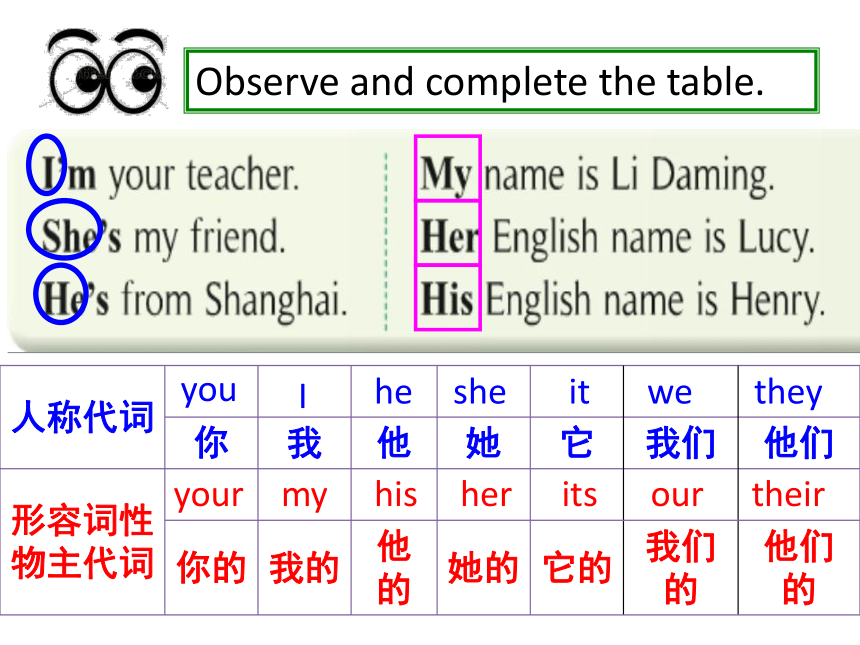
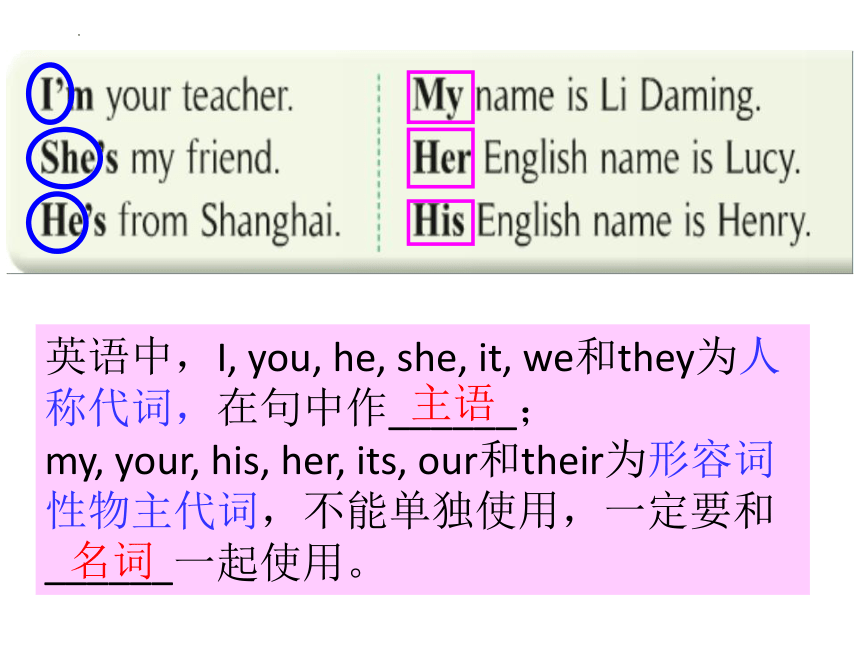
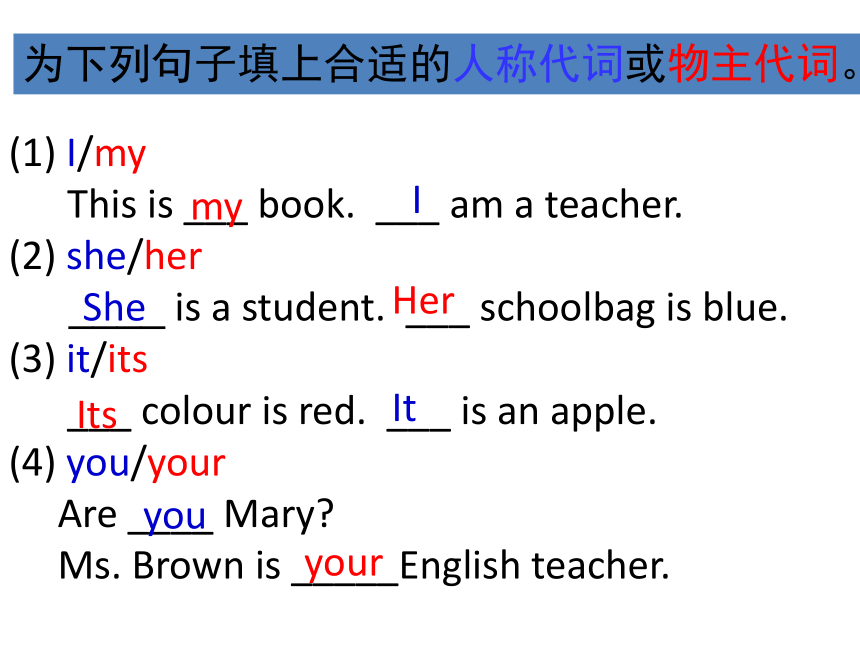
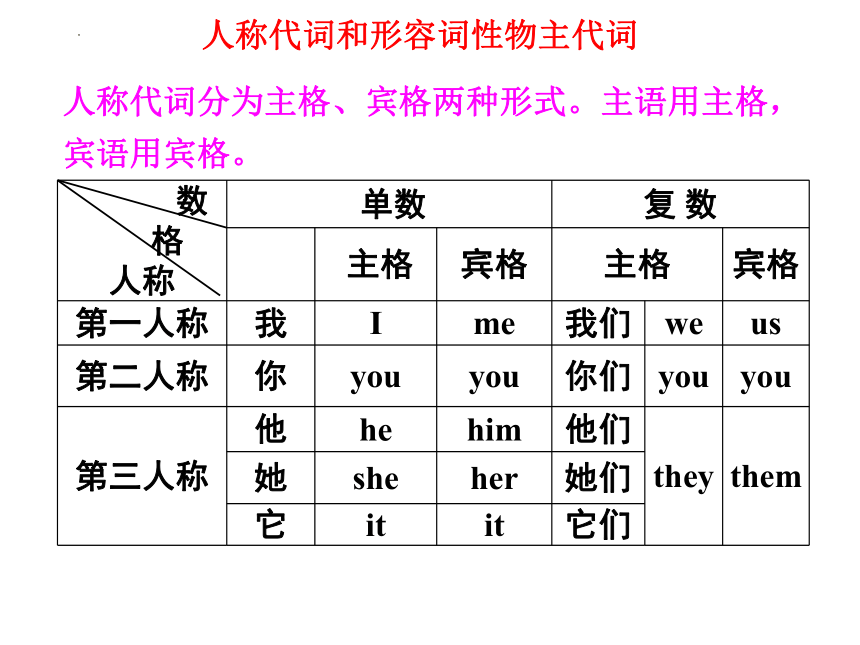
文档简介
(共102张PPT)
七年级英语语法复习
Module 1
上述圈出的部分都使用了_______一般现在时形式, 有三种形式:___, __, ____。
be动词
am
is
are
※如果有人问你的年龄、身份或者国籍,可以用be的一般现在时来回答。如:
I'm...
I am from...
Be动词的形式随主语的不同而有所变化。变化形式为:
I ___
He / She / It / My name ___
They / We / You ____
am
is
are
Be动词
1. 肯定句: 主语 + be
am
is + …
are
构成:
2. 否定句: 主语 + be + not + …
3. 一般疑问句: be+主语+…
肯定回答:Yes, 主语 + be.
否定回答: No, 主语 + be + not.
4. 特殊疑问句:特殊疑问词 + be + 主语…
I am = I'm You are = You're
He is = He's She is = She's
What is= What's It is = It's
is not = isn't are not = aren't
My name is = My name's
注意: be动词am,is,are与其前后
词的合写。
Tip:am not一般不缩写
1. be+形容词
He is very kind.
他人非常好。
2. be+名词
They are our friends.
他们是我们的好朋友。
3. be+介词短语
I'm in Class One.
我在一班。
4. be+副词
Class is over.
下课了。
一般说来,be 还可以用于下列几种情况:
My name is Elsa.
She is Anna.
He is Kristoff.
Her name is Anna.
His name is Kristoff.
I am Elsa.
人称代词
形容词性物主代词
Observe and complete the table.
人称代词
你 我 他 她 它 我们 他们
形容词性物主代词
你的 我的 他的 她的 它的 我们的 他们的
you
I
he
she
it
your
my
his
her
its
we
they
our
their
英语中,I, you, he, she, it, we和they为人称代词,在句中作______;
my, your, his, her, its, our和their为形容词性物主代词,不能单独使用,一定要和______一起使用。
主语
名词
(1) I/my
This is ___ book. ___ am a teacher.
(2) she/her
____ is a student. ___ schoolbag is blue.
(3) it/its
___ colour is red. ___ is an apple.
(4) you/your
Are ____ Mary
Ms. Brown is _____English teacher.
为下列句子填上合适的人称代词或物主代词。
I
my
She
Her
It
Its
you
your
人称代词和形容词性物主代词
人称代词分为主格、宾格两种形式。主语用主格,
宾语用宾格。
数 格 人称 单数 复 数
主格 宾格 主格 宾格
第一人称 我 I me 我们 we us
第二人称 你 you you 你们 you you
第三人称 他 he him 他们 they
them
她 she her 她们
它 it it 它们
形容词性物主代词是物主代词的一种,置于名词前,起修饰作用,表示“某人的”。
单数 复数
第一人称 我的 my 我们的 our
第二人称 你的 your 你们的 your
第三人称 他的 his 他们/她们/它们的 their
她的 her
它的 its
Review
英语姓名:
名
given name/first name
姓
family name/last name
中文姓名:
姓family name
/last name
名given name/first name
一、用be动词的适当形式填空。
1.You a teacher.Your name Li Ying.
2.We in Class 1 not Class 3.
3.—Who that boy —He Liu Hua.
4.—How old you —I ten.
5.Look at the leaves. They green but yellow.
aren’t
am
are
is
is
are
is
are
6.Kate’s father a doctor.
7.Mary and Ann girl students.
8.I thirteen years old, and Betty
thirteen years old too.
9.Tony in the playground.He is in the classroom.
10.Mr Wang very fat, but I .
am not
is
isn’t
is
am
are
is
二、语法点单句特训。
( )1. listen to teacher carefully.
A.Your;you B.We;our C.She; they D.His; his
( )2.Ken is friend. is a good student.
A.I;He B.I;His C.my;He D.my;His
C
B
( )3.—Is that dog —Yes. name is Lucky.
A.you;It B.you;Its C.your;It D.your;Its
( )4. school is big. like it.
A.Their; I B.They;I C.Our; My D.They; We
( )5.Mrs Green is teacher._____ is very kind.
A.her; Her B.her;She C.my; Her D.his; He
D
A
B
Module 2
this: 意为“这个”, 单数指
示代词;
that: 意为“那个”, 单数
指示代词;
these: 意为“这些”, 复数
指示代词;
this和these 是指距离较近
的人/物。
those: 意为“那些”, 复数
指示代词;
that和those 是指距离较远
的人/物。
指示代词的疑问句式:
指示代词的一般疑问句式:
be动词(is / are) + 指示代词(this, that, these, those) + 其他成分
肯定回答:
Yes, it is / they are.
否定回答:
No, it isn't / they aren't.
当询问人或事物的问句中含有this, that, these或those等指示代词时,其答语常用 it 代替this或that,用they代替these或those。
① 特殊疑问词(who) + is + that/this + 其他成分
肯定句:
This/That is… / These/Those are…
否定句:
指示代词 (this, that, these, those) + be动词(is / are) + not + 其他成分.
一般疑问句式及其答语:
① - Is this/that…
- Yes, it/he/she is. / No, it/he/she isn't.
特殊疑问句形式:
② 特殊疑问词(who) + are + these/those + 其他成分
② - Are these/those…
- Yes, they are. / No, they aren't.
名词所有格
所有格的构成
② 在以-s 或-es结尾的复数名词后只需加“ ' ”。
① 在单数名词的末尾加‘s构成名词的所有格,
表示“……的”。
the girls' bags 女孩们的书包
③ 在不以-s 或-es 结尾的复数名词后,加's
构成所有格。
⑤ 表示无生命物体的所有关系,一般用of。
④ 表示时间、距离的名词所有格与有生命
的名词所有格构成方法相同。
Women's Day 妇女节
the door of the classroom 教室的门
today's class 今天的课
一、语法点单句特训。
( )1.Are pencils your brother’s
A.this B.that C.these D.they
( )2.—Is this your ruler —Yes, .
A.this is B.that is C.it is D.he is
C
C
( )3.This is my room and that my brother’s room.
A.is B.are C.am D.be
( )4.—Ben, my brothers, Bob and John.
—Nice to meet you.
A.this is B.that is C.these are D.those are
( )5.These books are my .
A.sister’s B.sisters C.sister D.the sister’s
A
C
A
( )6.This is bedroom.
A. Wang Ling’s and Wang Ping’s
B. Wang Ling’s and Wang Ping
C. Wang Ling and Wang Ping’s
D. Wang Ling and Wang Ping
C
二、句型转换,每空一词。
1.This is my grandmother.(改为一般疑问句并作否定回答)
— your grandmother
—No, .
2.This is an English book.(改为复数句)
English .
books
These are
she isn’t
Is this
3.Those aren’t my watches.(改为单数句)
my .
4.These are Tony’s bags.(改为一般疑问句并作肯定回答)
— Tony’s bags
—Yes, .
they are
Are these
watch
That isn’t
Module 3
There be 句型
1. there be结构表示“某地有某人(某物)”。
2. be 在人称和数量上与其后的主语保持一致;
1) There is + 单数可数名词/不可数名词; / Is there+单数可数名词/不可数名词
2) There are + 复数可数名词./ Are there +复数可数名词
☆注意:如果有两个或两个以上的主语时,动词应与邻近的主语在数上保持一致。比如:
There ___a map and thirty desks in our classroom.
is
肯定句: There is/are + 某人/某物+……
句型结构总结:
否定句: There is/are not +某人/某物+……
一般疑问句: Is/Are there +某人/某物+……
Yes, there is/are.
No, there is/are not.
肯定答语:
否定答语:
特殊疑问句: 特殊疑问词+is/are there +……
在否定句和一般疑问句中,some要改为any。
注意:
There are some pictures on the classroom walls.
→ There aren't any pictures on the classroom walls.
→ Are there any pictures on the classroom walls
一、语法点单句特训。
( )1.There some tea in the bottle.
A.are B.is C.be D.am
( )2. there any books in the bag
A.Is B.Are C.Be D.Am
B
B
( )3. a cat, a dog and a bike next to the table.
A.There are B.It’s C.There is D.There aren’t
( )4.There aren’t birds in the tree.
A.some B.a C.an D.any
( )5.—Are there two pencils on the desk — .Only one. A.Yes, they are B.Yes, there are
C.No, there aren’t D.No, they aren’t
C
D
C
二、句型转换,每空一词。
1.There is a book on the desk.(改为一般疑问句并作否定回答)
— a book on the desk
— , .
2.There are some boys in the classroom.(改为一般疑问句并作肯定回答)
— boys in the classroom
— , .
there are
Yes
Are there any
there isn’t
No
Is there
3.There are eight pictures on the wall.(就画线部分提问)
________ _______ _______ ______ ______ on the wall
4.There are some photos on the wall.(改为否定句)
There photos on the wall.
aren’t any
How many picture are there
Grammar
方位介词
in on
under behind
in front of
next to near
on the left / right (of)
in the middle of between
on
under
near
next to
in front of
between…and…
behind
-Where is the apple
-It’s …
in
Translate the expressions into English.
1.在……中央 ________________
2.在……左边 ________________
3.在……后边 _________
4.在……和……的之间_______________
5.在……右边 _______________
6.在……前边 _____________
7.在……里边 ________
in the middle of…
on the left of…
behind…
between… and…
on the right of…
in front of…
in…
Task
Module 4
肯定句: 主语 + have/has got + …
否定句: 主语 + haven't/hasn't got + …
Yes, 主语 + have/has.
No, 主语 + haven't/hasn't.
一般疑问句: Have/Has + 主语 + got + …
特殊疑问句: 疑问词 + 一般疑问句
have/has got 的句型结构小结:
含义 关系
have/has got
there be
I have got a new book.
There is a new book on the desk.
She has got a lot of friends.
There are a lot of friends in the meeting room.
我有一本新书。
桌子上有一本新书。
她有很多朋友。
会议室里有很多朋友。
存在关系
所属关系
某人(拥)有
某地有某人或某物
1. ___ _____ any bread in the box
2. She ____ ____ a nice kite.
3. Under the tree, _____ _____ some
women drinking tea.
4. _____ _____ any cakes in your bag
5. ______ you ____ a white shirt
Is there
has got
there are
Are there
Have got
用 there be/have (has) got 的正确形式填空。
some与any的用法
some “一些” 用于肯定句:I would like some coffee.我想喝咖啡。
用于征求意见:Would you like some coffee 你想喝咖啡吗
May I have some coffee 我可以喝咖啡吗
What about some fruit juice (来些)果汁怎么样
any “一些” 用于疑问句:Can you see any birds 你能看到一些鸟吗
用于否定句:I can’t see any birds.我看不到任何鸟。
Plural forms of nouns
名词的复数形式及其变化规则
1. book → books song→songs
2. bus → buses box → boxes
watch → watches dish → dishes
3. city → cities body → bodies
story → stories factory → factories
4. piano→ pianos radio → radios
potato → potatoes
5. half → halves
knife → knives
一般情况下,加___
以__________结尾的名词,加-es
以辅音字母加-y结尾的名词,变__为___后加____
以o结尾的名词,有生命的加___,无生命的加___
以f, fe结尾的名词,去掉__或___加-ves
Observe and fill in the blanks.
-s
x, ch, sh, s
y
i
-es
es
s
f
fe
不规则变化:
man → men woman → women
child → children tooth → teeth
foot → feet
① 有些名词的单数与复数同形:
sheep → sheep Chinese → Chinese
Japanese → Japanese
不可数名词前面不能用定冠词a/an,也没有复数形式。它的“量”经常由可数名词来帮助表达,常用结构为:
不可数名词“量”的表达
three pieces of meat
two bowls of rice
two glasses of rice
数词 + 量词 + of + 不可数名词
1. 确切数量的表达方式:
①当表示“一杯/袋……”时,单位词要用单数形式;
a glass of water 一杯水
②当表示“两杯/袋……”时,单位词要用复数形式。
two glasses of water 两杯水
two cups of coffee 两杯咖啡
① some, any, plenty of, a lot of, lots of 等
(既可修饰不可数名词也可修饰可数名词)。
Please give me some paper.
We have got some apples.
② much, a great deal of, a bit of, a drop of,
a piece of, a little等(只可修饰不可数名词)。
I want a piece of chalk.
Please give me a little ink.
2. 不确切数量的表达方式:
当表示大概,不确定的数量时,可运用下列单词或短语:
语法点单句特训。
( )1.—What do you have for breakfast
—I usually have and .
A.bread; noodles B.breads; noodles
C.breads; noodle D.bread; noodle
( )2.I haven’t got cola. What about juice
A.any; any B.any; some
C.some; some D.some; any
B
A
( )3.Sam a dog,and his cousins ____a cat.
A.has got; has got B.has got; have got
C.have got; has got D.have got; have got
( )4.—Have they got any apples
— .Can you give them some
A.Yes, they have B.No, they haven’t
C.Yes, they has D.No, they hasn’t
( )5.There some meat and some bananas in the fridge.
A.am B.are C.is D.has
C
B
B
Module 5~8
past
分钟数不超过30分
half past
to
分钟数超过30分
o'clock
时间表达法
a quarter
英语时间表达:
一、整点 :
整点钟+o’clock 例如: ten o’clock
1)时间未过30分 : 分钟+past+点钟
例如:9:10 读成 ten past nine
2) 时间刚好是30分钟: half past + 点钟
例如 :9:30 读成 half past nine
3) 时间已过30分 :( 60 分钟) + to + (点钟 +1)
例如 :8:50=(60 50)+to+(8+1)=ten to nine
1.顺读法:先读小时数,后读分钟数
例如:eight ten(8:10)八点十分
二、含有小时和分钟:
2.逆读法:
表示“15分钟”,常用a quarter。
eg: 10:15读作:a quarter past ten;
2:45读作:a quarter to three
表示“在某一时刻”,即“在某时间点”,应该用介词at。
eg:at three o'clock在3点钟
对时刻提问时,一般用what time。
eg:—What time is it now?现在几点了?
—It's half past seven.七点半。
six twenty-five
twenty-five past six
6:25
5:00
five o’clock
8:15
eight fifteen
fifteen past eight
a quarter past eight
nine thirty
half past nine
9:30
6:45
six forty-five
fifteen to seven
a quarter to seven
时间介词(prepositions of time)
时间介词常用来表示时间状语,不同的时间所使用的介词也不相同,最常用的三个时间介词是at, on, in。
at用在某个时刻前
on用于星期或具体某天的上午、下午或晚上前
in 用在某段时间前;
★泛指在上午、下午或晚上;(固定搭配)
★也用在某季节、某周、某月、某年前面。
We have English ____ 9:00 and have a break ___ 10:00.
2. They have an English lesson _____ three o’clock ____ Tuesday.
3. I go to school ______ 8 o’clock in the morning.
4. We usually have a football match _____ Sunday.
5. — What time do you usually have your last class
— _____ five o’clock ____ the afternoon.
Practice
at
at
at
on
at
on
At
in
肯定句: 主语 + 行为动词+ ...
否定句: 主语 + do not + 行为动词+ ...
一般疑问句:Do + 主语 +行为动词+ ...
肯定答语:Yes, 主语+ do.
否定答语:No, 主语 + do not.
特殊疑问句:特殊疑问词 + do+主语+…?
句式结构小结
注意: 这里主语是指第一人称(I)、第一人称复数(we)、第二人称(you)或第三人称复数(they)
第一、二人称以及第三人称复数的一般现在时
1. I eat healthy food.
主语 + V +其他
主语+don’t+V+其他
1. I don’t eat unhealthy
food.
2. We don’t have dinner at
school.
3. You don’t sing very well.
4. They don’t know their
rights.
肯定式
否定式
2. We have dinner at school.
3. You sing very well.
主语:第一/二人称、第三人称
复数或复数名词
谓语动词:V原形
主语:第一/二人称、第三人
称复数或复数名词
谓语动词:
助动词don’t + V原形
主语为第三人称单数的时候,句式是怎样的呢?
4. They sing songs together every morning.
行为动词的一般现在时(Ⅱ)
当主语是第三人称单数(he / she / it )或单数名词时,其谓语动词要用第三人称单数形式。
1. It usually eats quite a lot.
2. He never listens to music.
3. She always wears school uniform.
主语:第三人称单数(he/she/it)
或单数名词
谓语动词:第三人称单数形式
主语为第三人称单数的一般现在时
构成方法 例词
动词第三人称单数形式的变化规则:
help→helps know→knows
get→gets read→reads
guess→guesses fix→fixes
teach→teaches wash→washes
go→goes
carry→carries
worry→worries
以字母s, x, sh, ch结尾的动词加-es
以字母o结尾的动词加-es
以辅音字母加y结尾的动词, 先变y为i,再加-es
在词尾加-s
肯定形式:主语 + 动词的单数第三人称形式+...
否定形式:主语 + doesn’t + 动词原形+...
疑问形式:Does + 主语 + 动词原形+...
肯定回答:Yes, 主语 + does.
否定回答:No, 主语 + doesn’t.
单数第三人称行为动词的各句式总结:
Summary
疑问词(组) 提问对象 例句
what What is your father
which Which one does she like
how How do you go to school
who Who is that girl in red
whose Whose bag is this
where Where is your home
when/what time When do you go to bed
why Why does Jim like the subject
how old How old is your elder sister
how many How many friends do you have
how much How much is the pen
对人或事物、职业提问
对特定的人或物提问
对行为方式或程度提问
询问某人是谁
对人称所有格即所属关系提问
对地点提问
对时间提问
对原因提问
对年龄提问
对可数名词的数量提问
对价格或不可数名词的量提问
一、语法点单句特训。
( )1.My grandparents TV and my parents read books after dinner.
A.look B.watch C.have D.do
B
( )2.—Do you have lunch at school
— .My home is not far from my school,so I go home for lunch.
A.Yes,I do B.No,I don’t
C.Yes,you do D.No,you don’t
( )3.— Tom’s classmates play basketball every day —Yes, they .
A.Is; are B.Are; are C.Do; do D.Are; do
B
C
( )4.What lessons you
A.are; like B.is; like C.does; like D.do; like
( )5.The boys their homework at weekends.
A.don’t do B.aren’t do
C.doesn’t do D.isn’t doing
A
D
二、用所给单词的适当形式填空。
1.They (start)lessons at nine o’clock.
2.Tom and Mike (watch)TV in the teaching building every Tuesday.
3. you (have)dinner at half past seven every day
4.I (not have)breakfast at home.
5.We (not read)in the library.
don’t read
don’t have
have
Do
watch
start
一、用所给单词的适当形式填空。
1.Han Mei usually (watch)TV on Saturday.
2.The giraffes (like)eating leaves.
3.That child (not like)ice cream.
4.They (not come)from America.
5. she (read)at home on Sunday
6. your dog (eat)fruit
eat
Does
read
Does
don’t come
doesn’t like
like
watches
二、语法点单句特训。
( )1.She a lot of tea. It’s her favourite.
A.drink B.drinks C.is drink D.are drink
( )2.People in our city a break at 11:30 in the morning.
A.have B.has C.is have D.are have
A
B
( )3.Sue is a very quiet girl. She very much.
A.not talk B.isn’t talk
C.don’t talk D.doesn’t talk
( )4.— the tiger come from Asia
—Yes,it .
A.Is; is B.Does; is C.Do; do D.Does; does
( )5. Tom and Jack basketball
A.Do;play B.Does; play
C.Does;plays D.Are;play
A
D
D
一、语法点单句特训。
( )1.— do you go to the zoo
—We go there on foot.
A.What B.How C.When D.Why
( )2.— letters do you send every day
—About 6.
A.How many B.How much
C.How soon D.How often
A
B
( )3.— does your mother do in the evening
—She usually watches TV.
A.When B.How C.What D.Where
( )4.— do the students science lessons
—In that building.
A.What; have B.How; has
C.When; having D.Where; have
D
C
( )5.Where your sister usually ______her homework
A.do; do B.does; do C.is; do D.are; do
B
总是
通常
经常
有时
很少
从不
100%
0%
usually
often
sometimes
never
always
seldom
常用的频度副词按频率大小从高到低的排列顺序是:
频度副词在句中一般位于行为动词之前,助动词或be动词之后。如:
1.What do you usually drink at home
你通常在家喝什么
2.They don’t often go to concerts.
他们不是经常去听音乐会。
3.He seldom goes to sleep before twelve o’clock.
他很少12点钟之前睡觉。
4.She is always at home at weekends.
周末她总是待在家里。
一、语法点单句特训。
( )1.My grandmother up at 5 o’clock in the morning.
A.get always B.always get
C.always gets D.gets always
C
( )2.Sam is late for school. He is always the first to get to school.
A.often B.always C.never D.usually
C
( )3.—Linda,do you like green
—Yes,I wear green clothes.
A.never B.hardly C.seldom D.often
D
( )4.My sister goes to bed early because she needs a lot of sleep every day.
A.always B.sometimes C.hardly D.never
( )5.—How often do you go skating
— .I can’t skate at all.
A.Always B.Sometimes C.Seldom D.Never
A
D
Module 9~10
句式结构
定义
时间状语
表示说话时正在进行或发生的动作或现阶段一直持续但说话时不一定进行的动作。
now, at the moment, at present, it‘s 9 o’clock ,these days及Look! Listen! 等
现在
进行时
肯定句:
主语 + be + V-ing+其他.
否定句:
主语 + be not + V-ing+其他.
V-ing变化规则:
①大多数动词后加ing。
②以不发音的e结尾的动词,去掉e, 再加ing。
③以ie结尾的动词,变ie为y, 再加ing。
④以一个辅音字母结尾的重读闭音节动词, 双写最后一个辅音字母,再加ing。
1) 肯定句:______________________
eg: Look at the picture. The children
are flying kites in the park.
2) 一般疑问句:_____________________
肯定回答:_______________
否定回答:__________________
eg: - Is he reading
- Yes, he is./No, he isn’t.
主语+ be + V-ing + 其他.
be+主语+V-ing+其他?
Yes, 主语+be.
No, 主语 + be + not.
现在进行时的句式
3) 特殊疑问句:
___________________
My mother is cooking dinner in the
kitchen.
Where is your mother cooking dinner
What is your mother doing in the
kitchen
Who is cooking dinner in the kitchen
疑问词 + 一般疑问句
What are they doing
They are walking.
Are they running
No, they aren't.
Is she lying on fallen leaves
Yes, she is.
Practice
Write about the pictures.
1.We play football every day
after school.
现在进行时
一般现在时
2. He cleans his room every
day.
3.They often come to China
for a visit.
1.We are playing football.
2. He is cleaning his room
now.
3. They are visiting China.
每天放学后我们都踢足球。
我们在踢足球。
他在打扫房间。
他每天都打扫房间。
他们经常来中国观光。
他们正在中国观光。
表示习惯性或经常性的行为
表示正在进行的行为
Practice
1. Amy ________ (do) her homework at the moment.
2. My father ________ (go) to work by bus every day.
3. Mike often ________ (play) basketball on Sunday.
4. Listen! Some people ___________ (sing) in the park.
5. Cindy ___________ (watch) the film My People, My Homeland now.
用括号内所给动词的适当形式填空。
is doing
goes
is watching
are singing
plays
一、用所给单词的适当形式填空。
1.---____ you _______(get) ready for Spring Festival
---Yes, we are.
2.---What’s your mother doing
--- She ________________(clean) the house and
________ (put) things away.
3.--- Is your father _______ (help) you ---No, he isn’t.
4.---What are Daming and Betty doing
---They ______________ (learn) a dragon dance
with my Grandpa.
5. It usually __________(come) in February, but sometimes it _________ (come)in January.
6.It ___________ (mean) lucky money.
Are getting
is cleaning
putting
helping
are learning
comes
comes
means
二、单项选择。
( )1. he sweeping the floor
A.Does B.Is C.Can D.Has
( )2.—Sam, come downstairs(楼下), please. I need your help.
—Sorry, Mum. I on the phone.
A.am talking B.talk C.talks D.talking
A
B
( )3.A woman with two children along(沿着) the street at the moment.
A.is walking B.are walking C.walk D.walks
( )4.We have to stay at home because it now.
A.is raining B.rained C.rain D.raining
( )5.—What the students
—They are cleaning the room.
A.do; do B.are; doing C.are; do D.do; doing
B
A
A
三、句型转换,每空一词。
1.She is reading in the room.(改为一般疑问句并作肯定回答)
— she in the room
— , .
2.The students are working on the farm.(改为一般疑问句并作否定回答)
— the students on the farm — , .
they aren’t
No
working
Are
she is
Yes
reading
Is
3.Li Qing is looking for his book.(划线部分提问)
Li Qiang
doing
is
What
4.Mary and Jack are drawing pictures in the park.(就画线部分提问)
Mary and Jack
pictures
5.She often shares food with others.
(用at the moment 改写句子)
She food with others . .
moment
at the
is sharing
drawing
Where are
用所给单词的适当形式填空。
1.She often_______ (read) books in her bedroom. But at the moment she __________ (read ) a book in the living room.
2. John ____________(have ) lunch at home now. He usually _______ (have) lunch at school.
3. Look! The students_____________ (swim)in the river. They _________ (swim) at weekends.
4. Sally often _____(do) the housework at weekends, She ___________(sweep) the floor now.
5. Mr Smith usually __________ (watch) English movies at weekends. Now he ____________ (watch) an English movie on TV.
reads
is reading
is having
has
are swimming
swim
does
is sweeping
watches
is watching
6. It's seven o'clock. She _________ (wait)
for the bus.
7.---_____ Tom ______ (clean)his room
every day
---No, he _________.
8. John________ (not lie) on the beach now.
He_______________(swim).
9. -What _____ they ______ (do )now
---They ___________ (play )table tennis.
10. He often_________(search )for
information on the Internet.
is waiting
Does clean
doesn’t
isn’t lying
is swimming
are doing
are playing
searches
C
C
B
D
D
Is cleaning
he is
Are walking
they aren’t
Where is
What are doing
5. The girls are cooking the meal for us in the kitchen.(对画线部分提问)
_____ _____ _______the meal for us in the kitchen
Who are cooking
四、根据汉语意思补全句子。
1.我妈妈正在和我的英语老师交谈。
My mother __ ______ _______ my English teacher.
2.他们正在买明信片吗
Are they ________ __________
3.看!他们在那边干什么 他们在下棋。
---Look! What are they doing over there
--- They _____ ______ chess.
4.吉姆正飞快地跑。我追不上他.
Jim ___ _______ very fast. I can't catch up with him.
5.我们正在用一个传统的家庭宴庆祝春节。
We ____ __________ Spring Festival with a traditional family dinner.
is talking with/to
buying postcards
are playing
is running
are celebrating
6.吉姆现在正在写作业。他通常晚上写作业。Jim ____ ______ his homework now. He usually _________ his homework in the evening.
7.看!珍妮正躺在床上看书。
Look! Jenny ____ _______in the bed and _______ a book.
8.一些人正在下公交车。
Some people _____ _________ ________ buses.
9.他们现在在参观长城吗 不,他们没有。
--- ______ they ________ the Great Wall right now No, they _______.
is doing
does
is lying
reading
are getting off
Are visiting
aren’t
五、根据短文内容用所给单词的适当形式填空
Everyone 1. ____ (have) his or her favourite festival. Now Betty and her friends are 2. _______ (talk) about it. Wu Peng is from Zhejiang. His favourite festival 3.______ (be )Dragon Boat Festival. On that day, he always 4.___________ (watch ) the dragon boat racing. It's very interesting. Zongzi with meat is his favourite food.
Zhou Jie is from Beijing. Spring Festival is her favourite festival. During Spring Festival, she doesn’t go to school and her parents aren’t at work. She can get 5. _________(luck )money from her grandparents. She often eats lots of 6.__________ (dumpling)during Spring festival.
has
talking
is
watches
lucky
dumplings
Mike is from the USA. Thanksgiving Day is 7. ____ (he) favourite. There is always a traditional linner in his family. There 8.____ (be) a turkey and pumpkin pies at the dinner table.
Linda is from England. Christmas Day is her favourite festival. She always gets many 9. _________ (present ). Her grandparents have a family dinner with them. They sing Christmas 10. _______ (song) They say "Merry Christmas“ to each other too. They’re very happy.
his
is
presents
songs
七年级英语语法复习
Module 1
上述圈出的部分都使用了_______一般现在时形式, 有三种形式:___, __, ____。
be动词
am
is
are
※如果有人问你的年龄、身份或者国籍,可以用be的一般现在时来回答。如:
I'm...
I am from...
Be动词的形式随主语的不同而有所变化。变化形式为:
I ___
He / She / It / My name ___
They / We / You ____
am
is
are
Be动词
1. 肯定句: 主语 + be
am
is + …
are
构成:
2. 否定句: 主语 + be + not + …
3. 一般疑问句: be+主语+…
肯定回答:Yes, 主语 + be.
否定回答: No, 主语 + be + not.
4. 特殊疑问句:特殊疑问词 + be + 主语…
I am = I'm You are = You're
He is = He's She is = She's
What is= What's It is = It's
is not = isn't are not = aren't
My name is = My name's
注意: be动词am,is,are与其前后
词的合写。
Tip:am not一般不缩写
1. be+形容词
He is very kind.
他人非常好。
2. be+名词
They are our friends.
他们是我们的好朋友。
3. be+介词短语
I'm in Class One.
我在一班。
4. be+副词
Class is over.
下课了。
一般说来,be 还可以用于下列几种情况:
My name is Elsa.
She is Anna.
He is Kristoff.
Her name is Anna.
His name is Kristoff.
I am Elsa.
人称代词
形容词性物主代词
Observe and complete the table.
人称代词
你 我 他 她 它 我们 他们
形容词性物主代词
你的 我的 他的 她的 它的 我们的 他们的
you
I
he
she
it
your
my
his
her
its
we
they
our
their
英语中,I, you, he, she, it, we和they为人称代词,在句中作______;
my, your, his, her, its, our和their为形容词性物主代词,不能单独使用,一定要和______一起使用。
主语
名词
(1) I/my
This is ___ book. ___ am a teacher.
(2) she/her
____ is a student. ___ schoolbag is blue.
(3) it/its
___ colour is red. ___ is an apple.
(4) you/your
Are ____ Mary
Ms. Brown is _____English teacher.
为下列句子填上合适的人称代词或物主代词。
I
my
She
Her
It
Its
you
your
人称代词和形容词性物主代词
人称代词分为主格、宾格两种形式。主语用主格,
宾语用宾格。
数 格 人称 单数 复 数
主格 宾格 主格 宾格
第一人称 我 I me 我们 we us
第二人称 你 you you 你们 you you
第三人称 他 he him 他们 they
them
她 she her 她们
它 it it 它们
形容词性物主代词是物主代词的一种,置于名词前,起修饰作用,表示“某人的”。
单数 复数
第一人称 我的 my 我们的 our
第二人称 你的 your 你们的 your
第三人称 他的 his 他们/她们/它们的 their
她的 her
它的 its
Review
英语姓名:
名
given name/first name
姓
family name/last name
中文姓名:
姓family name
/last name
名given name/first name
一、用be动词的适当形式填空。
1.You a teacher.Your name Li Ying.
2.We in Class 1 not Class 3.
3.—Who that boy —He Liu Hua.
4.—How old you —I ten.
5.Look at the leaves. They green but yellow.
aren’t
am
are
is
is
are
is
are
6.Kate’s father a doctor.
7.Mary and Ann girl students.
8.I thirteen years old, and Betty
thirteen years old too.
9.Tony in the playground.He is in the classroom.
10.Mr Wang very fat, but I .
am not
is
isn’t
is
am
are
is
二、语法点单句特训。
( )1. listen to teacher carefully.
A.Your;you B.We;our C.She; they D.His; his
( )2.Ken is friend. is a good student.
A.I;He B.I;His C.my;He D.my;His
C
B
( )3.—Is that dog —Yes. name is Lucky.
A.you;It B.you;Its C.your;It D.your;Its
( )4. school is big. like it.
A.Their; I B.They;I C.Our; My D.They; We
( )5.Mrs Green is teacher._____ is very kind.
A.her; Her B.her;She C.my; Her D.his; He
D
A
B
Module 2
this: 意为“这个”, 单数指
示代词;
that: 意为“那个”, 单数
指示代词;
these: 意为“这些”, 复数
指示代词;
this和these 是指距离较近
的人/物。
those: 意为“那些”, 复数
指示代词;
that和those 是指距离较远
的人/物。
指示代词的疑问句式:
指示代词的一般疑问句式:
be动词(is / are) + 指示代词(this, that, these, those) + 其他成分
肯定回答:
Yes, it is / they are.
否定回答:
No, it isn't / they aren't.
当询问人或事物的问句中含有this, that, these或those等指示代词时,其答语常用 it 代替this或that,用they代替these或those。
① 特殊疑问词(who) + is + that/this + 其他成分
肯定句:
This/That is… / These/Those are…
否定句:
指示代词 (this, that, these, those) + be动词(is / are) + not + 其他成分.
一般疑问句式及其答语:
① - Is this/that…
- Yes, it/he/she is. / No, it/he/she isn't.
特殊疑问句形式:
② 特殊疑问词(who) + are + these/those + 其他成分
② - Are these/those…
- Yes, they are. / No, they aren't.
名词所有格
所有格的构成
② 在以-s 或-es结尾的复数名词后只需加“ ' ”。
① 在单数名词的末尾加‘s构成名词的所有格,
表示“……的”。
the girls' bags 女孩们的书包
③ 在不以-s 或-es 结尾的复数名词后,加's
构成所有格。
⑤ 表示无生命物体的所有关系,一般用of。
④ 表示时间、距离的名词所有格与有生命
的名词所有格构成方法相同。
Women's Day 妇女节
the door of the classroom 教室的门
today's class 今天的课
一、语法点单句特训。
( )1.Are pencils your brother’s
A.this B.that C.these D.they
( )2.—Is this your ruler —Yes, .
A.this is B.that is C.it is D.he is
C
C
( )3.This is my room and that my brother’s room.
A.is B.are C.am D.be
( )4.—Ben, my brothers, Bob and John.
—Nice to meet you.
A.this is B.that is C.these are D.those are
( )5.These books are my .
A.sister’s B.sisters C.sister D.the sister’s
A
C
A
( )6.This is bedroom.
A. Wang Ling’s and Wang Ping’s
B. Wang Ling’s and Wang Ping
C. Wang Ling and Wang Ping’s
D. Wang Ling and Wang Ping
C
二、句型转换,每空一词。
1.This is my grandmother.(改为一般疑问句并作否定回答)
— your grandmother
—No, .
2.This is an English book.(改为复数句)
English .
books
These are
she isn’t
Is this
3.Those aren’t my watches.(改为单数句)
my .
4.These are Tony’s bags.(改为一般疑问句并作肯定回答)
— Tony’s bags
—Yes, .
they are
Are these
watch
That isn’t
Module 3
There be 句型
1. there be结构表示“某地有某人(某物)”。
2. be 在人称和数量上与其后的主语保持一致;
1) There is + 单数可数名词/不可数名词; / Is there+单数可数名词/不可数名词
2) There are + 复数可数名词./ Are there +复数可数名词
☆注意:如果有两个或两个以上的主语时,动词应与邻近的主语在数上保持一致。比如:
There ___a map and thirty desks in our classroom.
is
肯定句: There is/are + 某人/某物+……
句型结构总结:
否定句: There is/are not +某人/某物+……
一般疑问句: Is/Are there +某人/某物+……
Yes, there is/are.
No, there is/are not.
肯定答语:
否定答语:
特殊疑问句: 特殊疑问词+is/are there +……
在否定句和一般疑问句中,some要改为any。
注意:
There are some pictures on the classroom walls.
→ There aren't any pictures on the classroom walls.
→ Are there any pictures on the classroom walls
一、语法点单句特训。
( )1.There some tea in the bottle.
A.are B.is C.be D.am
( )2. there any books in the bag
A.Is B.Are C.Be D.Am
B
B
( )3. a cat, a dog and a bike next to the table.
A.There are B.It’s C.There is D.There aren’t
( )4.There aren’t birds in the tree.
A.some B.a C.an D.any
( )5.—Are there two pencils on the desk — .Only one. A.Yes, they are B.Yes, there are
C.No, there aren’t D.No, they aren’t
C
D
C
二、句型转换,每空一词。
1.There is a book on the desk.(改为一般疑问句并作否定回答)
— a book on the desk
— , .
2.There are some boys in the classroom.(改为一般疑问句并作肯定回答)
— boys in the classroom
— , .
there are
Yes
Are there any
there isn’t
No
Is there
3.There are eight pictures on the wall.(就画线部分提问)
________ _______ _______ ______ ______ on the wall
4.There are some photos on the wall.(改为否定句)
There photos on the wall.
aren’t any
How many picture are there
Grammar
方位介词
in on
under behind
in front of
next to near
on the left / right (of)
in the middle of between
on
under
near
next to
in front of
between…and…
behind
-Where is the apple
-It’s …
in
Translate the expressions into English.
1.在……中央 ________________
2.在……左边 ________________
3.在……后边 _________
4.在……和……的之间_______________
5.在……右边 _______________
6.在……前边 _____________
7.在……里边 ________
in the middle of…
on the left of…
behind…
between… and…
on the right of…
in front of…
in…
Task
Module 4
肯定句: 主语 + have/has got + …
否定句: 主语 + haven't/hasn't got + …
Yes, 主语 + have/has.
No, 主语 + haven't/hasn't.
一般疑问句: Have/Has + 主语 + got + …
特殊疑问句: 疑问词 + 一般疑问句
have/has got 的句型结构小结:
含义 关系
have/has got
there be
I have got a new book.
There is a new book on the desk.
She has got a lot of friends.
There are a lot of friends in the meeting room.
我有一本新书。
桌子上有一本新书。
她有很多朋友。
会议室里有很多朋友。
存在关系
所属关系
某人(拥)有
某地有某人或某物
1. ___ _____ any bread in the box
2. She ____ ____ a nice kite.
3. Under the tree, _____ _____ some
women drinking tea.
4. _____ _____ any cakes in your bag
5. ______ you ____ a white shirt
Is there
has got
there are
Are there
Have got
用 there be/have (has) got 的正确形式填空。
some与any的用法
some “一些” 用于肯定句:I would like some coffee.我想喝咖啡。
用于征求意见:Would you like some coffee 你想喝咖啡吗
May I have some coffee 我可以喝咖啡吗
What about some fruit juice (来些)果汁怎么样
any “一些” 用于疑问句:Can you see any birds 你能看到一些鸟吗
用于否定句:I can’t see any birds.我看不到任何鸟。
Plural forms of nouns
名词的复数形式及其变化规则
1. book → books song→songs
2. bus → buses box → boxes
watch → watches dish → dishes
3. city → cities body → bodies
story → stories factory → factories
4. piano→ pianos radio → radios
potato → potatoes
5. half → halves
knife → knives
一般情况下,加___
以__________结尾的名词,加-es
以辅音字母加-y结尾的名词,变__为___后加____
以o结尾的名词,有生命的加___,无生命的加___
以f, fe结尾的名词,去掉__或___加-ves
Observe and fill in the blanks.
-s
x, ch, sh, s
y
i
-es
es
s
f
fe
不规则变化:
man → men woman → women
child → children tooth → teeth
foot → feet
① 有些名词的单数与复数同形:
sheep → sheep Chinese → Chinese
Japanese → Japanese
不可数名词前面不能用定冠词a/an,也没有复数形式。它的“量”经常由可数名词来帮助表达,常用结构为:
不可数名词“量”的表达
three pieces of meat
two bowls of rice
two glasses of rice
数词 + 量词 + of + 不可数名词
1. 确切数量的表达方式:
①当表示“一杯/袋……”时,单位词要用单数形式;
a glass of water 一杯水
②当表示“两杯/袋……”时,单位词要用复数形式。
two glasses of water 两杯水
two cups of coffee 两杯咖啡
① some, any, plenty of, a lot of, lots of 等
(既可修饰不可数名词也可修饰可数名词)。
Please give me some paper.
We have got some apples.
② much, a great deal of, a bit of, a drop of,
a piece of, a little等(只可修饰不可数名词)。
I want a piece of chalk.
Please give me a little ink.
2. 不确切数量的表达方式:
当表示大概,不确定的数量时,可运用下列单词或短语:
语法点单句特训。
( )1.—What do you have for breakfast
—I usually have and .
A.bread; noodles B.breads; noodles
C.breads; noodle D.bread; noodle
( )2.I haven’t got cola. What about juice
A.any; any B.any; some
C.some; some D.some; any
B
A
( )3.Sam a dog,and his cousins ____a cat.
A.has got; has got B.has got; have got
C.have got; has got D.have got; have got
( )4.—Have they got any apples
— .Can you give them some
A.Yes, they have B.No, they haven’t
C.Yes, they has D.No, they hasn’t
( )5.There some meat and some bananas in the fridge.
A.am B.are C.is D.has
C
B
B
Module 5~8
past
分钟数不超过30分
half past
to
分钟数超过30分
o'clock
时间表达法
a quarter
英语时间表达:
一、整点 :
整点钟+o’clock 例如: ten o’clock
1)时间未过30分 : 分钟+past+点钟
例如:9:10 读成 ten past nine
2) 时间刚好是30分钟: half past + 点钟
例如 :9:30 读成 half past nine
3) 时间已过30分 :( 60 分钟) + to + (点钟 +1)
例如 :8:50=(60 50)+to+(8+1)=ten to nine
1.顺读法:先读小时数,后读分钟数
例如:eight ten(8:10)八点十分
二、含有小时和分钟:
2.逆读法:
表示“15分钟”,常用a quarter。
eg: 10:15读作:a quarter past ten;
2:45读作:a quarter to three
表示“在某一时刻”,即“在某时间点”,应该用介词at。
eg:at three o'clock在3点钟
对时刻提问时,一般用what time。
eg:—What time is it now?现在几点了?
—It's half past seven.七点半。
six twenty-five
twenty-five past six
6:25
5:00
five o’clock
8:15
eight fifteen
fifteen past eight
a quarter past eight
nine thirty
half past nine
9:30
6:45
six forty-five
fifteen to seven
a quarter to seven
时间介词(prepositions of time)
时间介词常用来表示时间状语,不同的时间所使用的介词也不相同,最常用的三个时间介词是at, on, in。
at用在某个时刻前
on用于星期或具体某天的上午、下午或晚上前
in 用在某段时间前;
★泛指在上午、下午或晚上;(固定搭配)
★也用在某季节、某周、某月、某年前面。
We have English ____ 9:00 and have a break ___ 10:00.
2. They have an English lesson _____ three o’clock ____ Tuesday.
3. I go to school ______ 8 o’clock in the morning.
4. We usually have a football match _____ Sunday.
5. — What time do you usually have your last class
— _____ five o’clock ____ the afternoon.
Practice
at
at
at
on
at
on
At
in
肯定句: 主语 + 行为动词+ ...
否定句: 主语 + do not + 行为动词+ ...
一般疑问句:Do + 主语 +行为动词+ ...
肯定答语:Yes, 主语+ do.
否定答语:No, 主语 + do not.
特殊疑问句:特殊疑问词 + do+主语+…?
句式结构小结
注意: 这里主语是指第一人称(I)、第一人称复数(we)、第二人称(you)或第三人称复数(they)
第一、二人称以及第三人称复数的一般现在时
1. I eat healthy food.
主语 + V +其他
主语+don’t+V+其他
1. I don’t eat unhealthy
food.
2. We don’t have dinner at
school.
3. You don’t sing very well.
4. They don’t know their
rights.
肯定式
否定式
2. We have dinner at school.
3. You sing very well.
主语:第一/二人称、第三人称
复数或复数名词
谓语动词:V原形
主语:第一/二人称、第三人
称复数或复数名词
谓语动词:
助动词don’t + V原形
主语为第三人称单数的时候,句式是怎样的呢?
4. They sing songs together every morning.
行为动词的一般现在时(Ⅱ)
当主语是第三人称单数(he / she / it )或单数名词时,其谓语动词要用第三人称单数形式。
1. It usually eats quite a lot.
2. He never listens to music.
3. She always wears school uniform.
主语:第三人称单数(he/she/it)
或单数名词
谓语动词:第三人称单数形式
主语为第三人称单数的一般现在时
构成方法 例词
动词第三人称单数形式的变化规则:
help→helps know→knows
get→gets read→reads
guess→guesses fix→fixes
teach→teaches wash→washes
go→goes
carry→carries
worry→worries
以字母s, x, sh, ch结尾的动词加-es
以字母o结尾的动词加-es
以辅音字母加y结尾的动词, 先变y为i,再加-es
在词尾加-s
肯定形式:主语 + 动词的单数第三人称形式+...
否定形式:主语 + doesn’t + 动词原形+...
疑问形式:Does + 主语 + 动词原形+...
肯定回答:Yes, 主语 + does.
否定回答:No, 主语 + doesn’t.
单数第三人称行为动词的各句式总结:
Summary
疑问词(组) 提问对象 例句
what What is your father
which Which one does she like
how How do you go to school
who Who is that girl in red
whose Whose bag is this
where Where is your home
when/what time When do you go to bed
why Why does Jim like the subject
how old How old is your elder sister
how many How many friends do you have
how much How much is the pen
对人或事物、职业提问
对特定的人或物提问
对行为方式或程度提问
询问某人是谁
对人称所有格即所属关系提问
对地点提问
对时间提问
对原因提问
对年龄提问
对可数名词的数量提问
对价格或不可数名词的量提问
一、语法点单句特训。
( )1.My grandparents TV and my parents read books after dinner.
A.look B.watch C.have D.do
B
( )2.—Do you have lunch at school
— .My home is not far from my school,so I go home for lunch.
A.Yes,I do B.No,I don’t
C.Yes,you do D.No,you don’t
( )3.— Tom’s classmates play basketball every day —Yes, they .
A.Is; are B.Are; are C.Do; do D.Are; do
B
C
( )4.What lessons you
A.are; like B.is; like C.does; like D.do; like
( )5.The boys their homework at weekends.
A.don’t do B.aren’t do
C.doesn’t do D.isn’t doing
A
D
二、用所给单词的适当形式填空。
1.They (start)lessons at nine o’clock.
2.Tom and Mike (watch)TV in the teaching building every Tuesday.
3. you (have)dinner at half past seven every day
4.I (not have)breakfast at home.
5.We (not read)in the library.
don’t read
don’t have
have
Do
watch
start
一、用所给单词的适当形式填空。
1.Han Mei usually (watch)TV on Saturday.
2.The giraffes (like)eating leaves.
3.That child (not like)ice cream.
4.They (not come)from America.
5. she (read)at home on Sunday
6. your dog (eat)fruit
eat
Does
read
Does
don’t come
doesn’t like
like
watches
二、语法点单句特训。
( )1.She a lot of tea. It’s her favourite.
A.drink B.drinks C.is drink D.are drink
( )2.People in our city a break at 11:30 in the morning.
A.have B.has C.is have D.are have
A
B
( )3.Sue is a very quiet girl. She very much.
A.not talk B.isn’t talk
C.don’t talk D.doesn’t talk
( )4.— the tiger come from Asia
—Yes,it .
A.Is; is B.Does; is C.Do; do D.Does; does
( )5. Tom and Jack basketball
A.Do;play B.Does; play
C.Does;plays D.Are;play
A
D
D
一、语法点单句特训。
( )1.— do you go to the zoo
—We go there on foot.
A.What B.How C.When D.Why
( )2.— letters do you send every day
—About 6.
A.How many B.How much
C.How soon D.How often
A
B
( )3.— does your mother do in the evening
—She usually watches TV.
A.When B.How C.What D.Where
( )4.— do the students science lessons
—In that building.
A.What; have B.How; has
C.When; having D.Where; have
D
C
( )5.Where your sister usually ______her homework
A.do; do B.does; do C.is; do D.are; do
B
总是
通常
经常
有时
很少
从不
100%
0%
usually
often
sometimes
never
always
seldom
常用的频度副词按频率大小从高到低的排列顺序是:
频度副词在句中一般位于行为动词之前,助动词或be动词之后。如:
1.What do you usually drink at home
你通常在家喝什么
2.They don’t often go to concerts.
他们不是经常去听音乐会。
3.He seldom goes to sleep before twelve o’clock.
他很少12点钟之前睡觉。
4.She is always at home at weekends.
周末她总是待在家里。
一、语法点单句特训。
( )1.My grandmother up at 5 o’clock in the morning.
A.get always B.always get
C.always gets D.gets always
C
( )2.Sam is late for school. He is always the first to get to school.
A.often B.always C.never D.usually
C
( )3.—Linda,do you like green
—Yes,I wear green clothes.
A.never B.hardly C.seldom D.often
D
( )4.My sister goes to bed early because she needs a lot of sleep every day.
A.always B.sometimes C.hardly D.never
( )5.—How often do you go skating
— .I can’t skate at all.
A.Always B.Sometimes C.Seldom D.Never
A
D
Module 9~10
句式结构
定义
时间状语
表示说话时正在进行或发生的动作或现阶段一直持续但说话时不一定进行的动作。
now, at the moment, at present, it‘s 9 o’clock ,these days及Look! Listen! 等
现在
进行时
肯定句:
主语 + be + V-ing+其他.
否定句:
主语 + be not + V-ing+其他.
V-ing变化规则:
①大多数动词后加ing。
②以不发音的e结尾的动词,去掉e, 再加ing。
③以ie结尾的动词,变ie为y, 再加ing。
④以一个辅音字母结尾的重读闭音节动词, 双写最后一个辅音字母,再加ing。
1) 肯定句:______________________
eg: Look at the picture. The children
are flying kites in the park.
2) 一般疑问句:_____________________
肯定回答:_______________
否定回答:__________________
eg: - Is he reading
- Yes, he is./No, he isn’t.
主语+ be + V-ing + 其他.
be+主语+V-ing+其他?
Yes, 主语+be.
No, 主语 + be + not.
现在进行时的句式
3) 特殊疑问句:
___________________
My mother is cooking dinner in the
kitchen.
Where is your mother cooking dinner
What is your mother doing in the
kitchen
Who is cooking dinner in the kitchen
疑问词 + 一般疑问句
What are they doing
They are walking.
Are they running
No, they aren't.
Is she lying on fallen leaves
Yes, she is.
Practice
Write about the pictures.
1.We play football every day
after school.
现在进行时
一般现在时
2. He cleans his room every
day.
3.They often come to China
for a visit.
1.We are playing football.
2. He is cleaning his room
now.
3. They are visiting China.
每天放学后我们都踢足球。
我们在踢足球。
他在打扫房间。
他每天都打扫房间。
他们经常来中国观光。
他们正在中国观光。
表示习惯性或经常性的行为
表示正在进行的行为
Practice
1. Amy ________ (do) her homework at the moment.
2. My father ________ (go) to work by bus every day.
3. Mike often ________ (play) basketball on Sunday.
4. Listen! Some people ___________ (sing) in the park.
5. Cindy ___________ (watch) the film My People, My Homeland now.
用括号内所给动词的适当形式填空。
is doing
goes
is watching
are singing
plays
一、用所给单词的适当形式填空。
1.---____ you _______(get) ready for Spring Festival
---Yes, we are.
2.---What’s your mother doing
--- She ________________(clean) the house and
________ (put) things away.
3.--- Is your father _______ (help) you ---No, he isn’t.
4.---What are Daming and Betty doing
---They ______________ (learn) a dragon dance
with my Grandpa.
5. It usually __________(come) in February, but sometimes it _________ (come)in January.
6.It ___________ (mean) lucky money.
Are getting
is cleaning
putting
helping
are learning
comes
comes
means
二、单项选择。
( )1. he sweeping the floor
A.Does B.Is C.Can D.Has
( )2.—Sam, come downstairs(楼下), please. I need your help.
—Sorry, Mum. I on the phone.
A.am talking B.talk C.talks D.talking
A
B
( )3.A woman with two children along(沿着) the street at the moment.
A.is walking B.are walking C.walk D.walks
( )4.We have to stay at home because it now.
A.is raining B.rained C.rain D.raining
( )5.—What the students
—They are cleaning the room.
A.do; do B.are; doing C.are; do D.do; doing
B
A
A
三、句型转换,每空一词。
1.She is reading in the room.(改为一般疑问句并作肯定回答)
— she in the room
— , .
2.The students are working on the farm.(改为一般疑问句并作否定回答)
— the students on the farm — , .
they aren’t
No
working
Are
she is
Yes
reading
Is
3.Li Qing is looking for his book.(划线部分提问)
Li Qiang
doing
is
What
4.Mary and Jack are drawing pictures in the park.(就画线部分提问)
Mary and Jack
pictures
5.She often shares food with others.
(用at the moment 改写句子)
She food with others . .
moment
at the
is sharing
drawing
Where are
用所给单词的适当形式填空。
1.She often_______ (read) books in her bedroom. But at the moment she __________ (read ) a book in the living room.
2. John ____________(have ) lunch at home now. He usually _______ (have) lunch at school.
3. Look! The students_____________ (swim)in the river. They _________ (swim) at weekends.
4. Sally often _____(do) the housework at weekends, She ___________(sweep) the floor now.
5. Mr Smith usually __________ (watch) English movies at weekends. Now he ____________ (watch) an English movie on TV.
reads
is reading
is having
has
are swimming
swim
does
is sweeping
watches
is watching
6. It's seven o'clock. She _________ (wait)
for the bus.
7.---_____ Tom ______ (clean)his room
every day
---No, he _________.
8. John________ (not lie) on the beach now.
He_______________(swim).
9. -What _____ they ______ (do )now
---They ___________ (play )table tennis.
10. He often_________(search )for
information on the Internet.
is waiting
Does clean
doesn’t
isn’t lying
is swimming
are doing
are playing
searches
C
C
B
D
D
Is cleaning
he is
Are walking
they aren’t
Where is
What are doing
5. The girls are cooking the meal for us in the kitchen.(对画线部分提问)
_____ _____ _______the meal for us in the kitchen
Who are cooking
四、根据汉语意思补全句子。
1.我妈妈正在和我的英语老师交谈。
My mother __ ______ _______ my English teacher.
2.他们正在买明信片吗
Are they ________ __________
3.看!他们在那边干什么 他们在下棋。
---Look! What are they doing over there
--- They _____ ______ chess.
4.吉姆正飞快地跑。我追不上他.
Jim ___ _______ very fast. I can't catch up with him.
5.我们正在用一个传统的家庭宴庆祝春节。
We ____ __________ Spring Festival with a traditional family dinner.
is talking with/to
buying postcards
are playing
is running
are celebrating
6.吉姆现在正在写作业。他通常晚上写作业。Jim ____ ______ his homework now. He usually _________ his homework in the evening.
7.看!珍妮正躺在床上看书。
Look! Jenny ____ _______in the bed and _______ a book.
8.一些人正在下公交车。
Some people _____ _________ ________ buses.
9.他们现在在参观长城吗 不,他们没有。
--- ______ they ________ the Great Wall right now No, they _______.
is doing
does
is lying
reading
are getting off
Are visiting
aren’t
五、根据短文内容用所给单词的适当形式填空
Everyone 1. ____ (have) his or her favourite festival. Now Betty and her friends are 2. _______ (talk) about it. Wu Peng is from Zhejiang. His favourite festival 3.______ (be )Dragon Boat Festival. On that day, he always 4.___________ (watch ) the dragon boat racing. It's very interesting. Zongzi with meat is his favourite food.
Zhou Jie is from Beijing. Spring Festival is her favourite festival. During Spring Festival, she doesn’t go to school and her parents aren’t at work. She can get 5. _________(luck )money from her grandparents. She often eats lots of 6.__________ (dumpling)during Spring festival.
has
talking
is
watches
lucky
dumplings
Mike is from the USA. Thanksgiving Day is 7. ____ (he) favourite. There is always a traditional linner in his family. There 8.____ (be) a turkey and pumpkin pies at the dinner table.
Linda is from England. Christmas Day is her favourite festival. She always gets many 9. _________ (present ). Her grandparents have a family dinner with them. They sing Christmas 10. _______ (song) They say "Merry Christmas“ to each other too. They’re very happy.
his
is
presents
songs
同课章节目录
